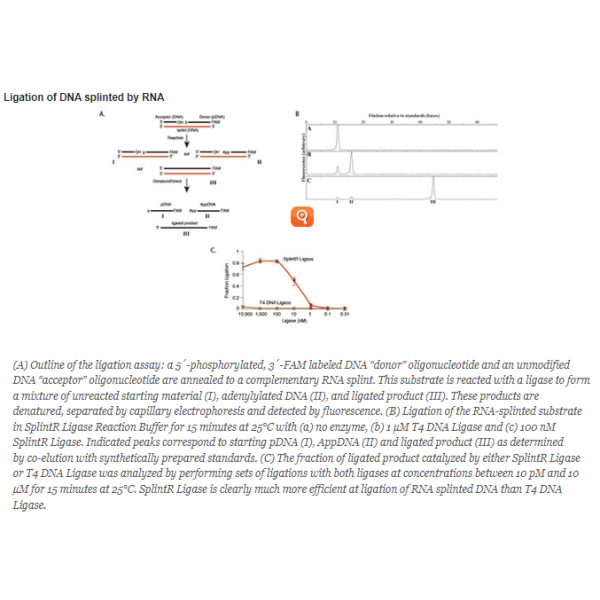M0375S, SplintR Ligase - 1.250 units
SplintR Ligase, also known as PBCV-1 DNA Ligase or Chlorella virus DNA Ligase, efficiently catalyzes the ligation of adjacent, single-stranded DNA splinted by a complementary RNA strand.
SplintR Ligase, also known as PBCV-1 DNA Ligase or Chlorella virus DNA Ligase, efficiently catalyzes the ligation of adjacent, single-stranded DNA splinted by a complementary RNA strand. This previously unreported activity may enable novel approaches for characterization of miRNAs and mRNAs, including SNPs. SplintR is ideally suited for many target enrichment workflows with applications in next-generation sequencing and molecular diagnostics. The robust activity of the enzyme and its affinity for RNA-splinted DNA substrates (apparent Km = 1 nM) enable sub-nanomolar detection of unique RNA species within a complex mixture, making SplintR ligase a superior choice for demanding RNA detection technologies.
The enzyme is active over a broad range of ATP concentrations (10 µM – 1 mM) and pH (6.5–9). Optimal activity is observed using Mg2+ > 5 mM, and a pH between 7.5 and 8.0. The activity is enhanced at higher temperatures (up to 37°C), and by supplementation with 5 mM Mn2+. The reaction is inhibited by salt concentrations in excess of 100 mM.
The enzyme tolerates all base pair combinations at the ligation junction, but is partially inhibited by dC/G and dG/C base pairs at the donor (phosphorylated) side ligation junction, particularly when the +2 base was also a C/G base pair.
Product Source
An E. coli strain that carries a recombinant gene encoding PBCV-1 DNA Ligase.
| Price | 690,00 RON (preturile sunt fara TVA) |
|---|---|
| Description |
SplintR Ligase, also known as PBCV-1 DNA Ligase or Chlorella virus DNA Ligase, efficiently catalyzes the ligation of adjacent, single-stranded DNA splinted by a complementary RNA strand. This previously unreported activity may enable novel approaches for characterization of miRNAs and mRNAs, including SNPs. SplintR is ideally suited for many target enrichment workflows with applications in next-generation sequencing and molecular diagnostics. The robust activity of the enzyme and its affinity for RNA-splinted DNA substrates (apparent Km = 1 nM) enable sub-nanomolar detection of unique RNA species within a complex mixture, making SplintR ligase a superior choice for demanding RNA detection technologies. Product Source An E. coli strain that carries a recombinant gene encoding PBCV-1 DNA Ligase.
|

 English
English




